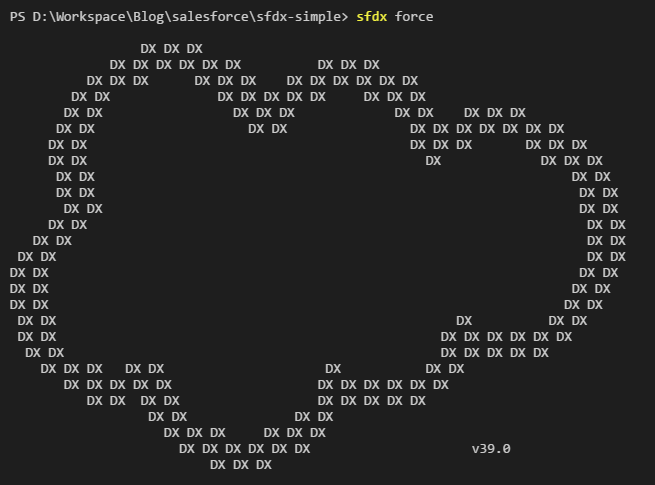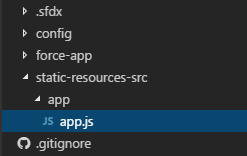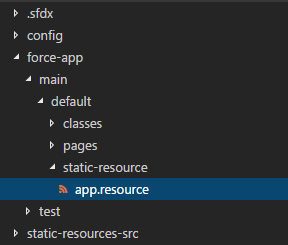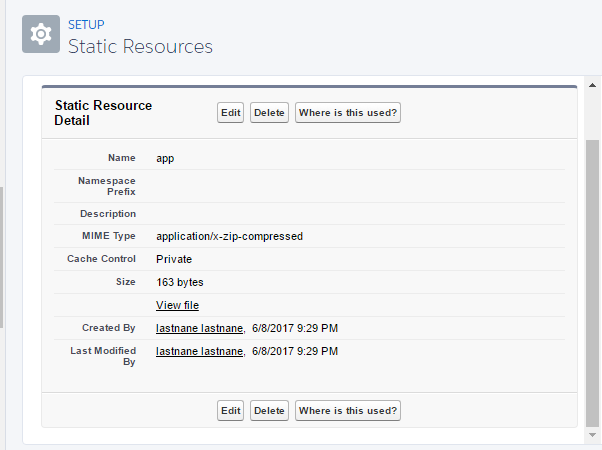
Salesforce DX – Static Resources
Brett M. Nelson - Thursday, June 8, 2017
We have been able to create an Apex class and a Visualforce page so far. Let's try to add a static resource.
Create the Source
Before we can create a static resource we should have something to put in it. For that purpose I have created a folder at the root of the sfdx-simple project called static-resources-src and if you guessed that I plan on keeping all the source files for my static resources there you would be correct, good job!
Why didn't I create this within the force-app folder you may be wondering. It causes an error. Having a .js file in a PackageDirectory causes the following error when you check the status:
sfdx force:source:status
PS D:\Workspace\Blog\salesforce\sfdx-simple> sfdx force:source:status ERROR running force:source:status: Unexpected file found in package directory: D:\Workspace\Blog\salesforce\sfdx-simple\force-app\app.js. PS D:\Workspace\Blog\salesforce\sfdx-simple>
This is probably because there is no standalone .js file extensions in Salesforce.
In static-resources-src I created a folder with the ever so original name of app and in the app folder I added a JavaScript file called app.js this will be where I keep all my app code for now.
app.js

In case you are wondering I have decided to use plain JavaScript for this since the choice of framework in revilement if you can't send it to the server.
For the app.js I'm just going to create an Immediately-Invoked Function Expression (IIFE) that passes the window object in and logs it to the console.
app.js
;((window)=>{ console.log({window}) })(window)
Since I am on Windows and I don't have any build pipe line in place at the momment I am going to manually zip the app folder, changes the file extension from .zip to .resource and move in to a folder in the force-app/main/default/static-resources.
app.resource

Now if we check the status we see that the there are 2 local adds.
sfdx force:source:status Take II
PS D:\Workspace\Blog\salesforce\sfdx-simple> sfdx force:source:status State Full Name Type Workspace Path ───────── ───────── ────────────── ──────────────────────────────────────────────────────────── Local Add app StaticResource force-app\main\default\static-resource\app.resource-meta.xml Local Add app StaticResource force-app\main\default\static-resource\app.resource PS D:\Workspace\Blog\salesforce\sfdx-simple>
Let's push it and see what happens.
Push It
Let's try the sfdx force:source:push command to push our static resource to the scratch org.
sfdx force:source:push
PS D:\Workspace\Blog\salesforce\sfdx-simple> sfdx force:source:push ERROR running force:source:push: ENOENT: no such file or directory, lstat 'D:\Workspace\Blog\salesforce\sfdx-simple\force-app\main\default\static-resource\app.resource-m eta.xml'. PS D:\Workspace\Blog\salesforce\sfdx-simple>
So that doesn't look like it is going to work.
Lets go to our org with the sfdx force:org:open command and add a static resource in the setup menu for now.
app Static Resource Details

ok, so I used a zip file I created from our app source folder but this is suppose to be source driven development and uploading from the Setup menu is going to get old. Theres also that sfdx force:source:push thing that should be doing this work for us. If only we could get the generated app.resource-meta.xml to use.
Pull It
No, I'm not talking about my finger. We are going to use the sfdx force:source:pull command to get any changes that happened in our org back into our local source code.
sfdx force:source:pull
PS D:\Workspace\Blog\salesforce\sfdx-simple> sfdx force:source:pull State Full Name Type Workspace Path ─────── ───────── ────────────── ──────────────────────────────────────────────────────────── Changed app StaticResource force-app\main\default\staticresources\app.resource-meta.xml Changed app StaticResource force-app\main\default\staticresources\app.resource PS D:\Workspace\Blog\salesforce\sfdx-simple>
It pulled everything down into the default folder at force-app\main\default\staticresources\. This seems like a good enough place to me so I'm going to remove my oh so dramatically differently named static-resources folder.
Check the App
Now we know we have our static resource in Salesforce lets add a script reference to it on our Contacts.page and verify it is logging the window when the page loads.
First the reference, just add it on the Contacts.page.
app.js reference
Now push once more time.
Last sfdx force:source:push
PS D:\Workspace\Blog\salesforce\sfdx-simple> sfdx force:source:push State Full Name Type Workspace Path ─────── ───────── ──────── ─────────────────────────────────────────────────── Changed Contacts ApexPage force-app\main\default\pages\Contacts.page-meta.xml Changed Contacts ApexPage force-app\main\default\pages\Contacts.page
Now open up the Contats.page with sfdx force:org:open --path apex/Contacts and look at the console.
Contacts Console

There you have it, our window object.
Conclusion
Uploading the app static resource was a but annoying but I think we can make it a little easier with something like NPM Scripts, or Gulp Tasks or something. What would you prefer to try? Let me know what you think by leaving a comment below, emailing [email protected] or following and yelling at me on Twitter/BrettMN.